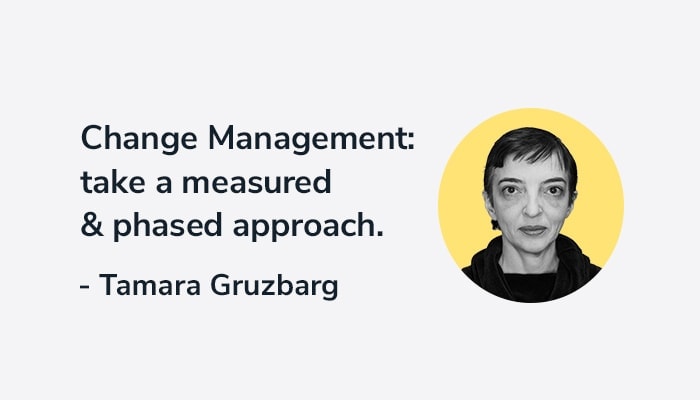CDP Change Management: Change Comes from Within

Reflecting on my 20+ years in the field of customer analytics, I’ve come to the realization that one of my biggest challenges has always been getting my business counterparts in the organization to look at a customer holistically. I don’t mean this from a data perspective—I’ve seen great success helping bring together disparate data for a unified view of the customer. Rather, I have often presented a report, an analysis, or a data-driven recommendation, and gotten questions like:
- Wait, did this digital campaign cannibalize my store sales?
- Why are you including “best customers” in the “term life” campaign file, when we need to be selling them disability insurance?
- These are my customers, they shop for women’s apparel! Why would we promote home goods to them?
I encountered this attitude pretty consistently a long time before the term “customer-centricity” was coined. And the appearance of this term, while very helpful, still has not solved the problem.
From Silos to Customer-Centricity
Indeed, people tend to think about their jobs from the P&L ownership and incentives perspective. Very few are ready to accept the fact that the customer couldn’t care less who owns the P&L. She does not care whether she is classified as a “store customer” or “online customer” in the internal database or reports. She wants an experience that makes sense for her. She wants to feel that the brand “gets” her. And if she doesn’t, she will leave. It’s that easy!
That’s why I became so excited about the promise of the CDP—and not just because it helps to enable truly personalized customer experiences by virtue of:
- Unifying data across silos to provide a single view of the customer
- Uncovering insights from the data such as next best product or offer
- Activating on these insights seamlessly across all customer touchpoints
The CDP industry is exciting because it has the potential to change the way brands operate inside their organizations. Such as:
- Driving separate teams to see each customer as an individual, not as a policy number, email address or cookie
- Serving as a hub of coordination for disparate teams responsible for customer experience to operate in tandem
Visionary customer experience leaders like Daren Hull of Vera Bradley recognize this opportunity and are prepared to act on it. “We don’t want our org chart getting in the way of someone having a great experience,” he says. Of course, it is much easier said than done…
(Read our Vera Bradley case study to learn how they got it done).
The Risks and Rewards of Change
Change is hard. And, in fact, it’s one of the biggest risks organizations face when bringing in a technology to transform the customer experience—be it a CDP or another enterprise technology solution.
There is no “easy” button to push that will magically improve everything. There is no software in the world that can guarantee success. At the end of the day, it’s about the people using the software and the organization’s readiness for change. These are the deciding factors in determining whether the brand succeeds and is positioned to become a market leader, or if “breaks” and trudges down a path of mediocrity—or worse.
That’s why my personal passion since joining ActionIQ (we develop a leading enterprise CDP) has been to ensure that we are focused on more than just software in enabling our clients to build a strong foundation for delivering personalized customer experiences at scale. This includes providing guidance to brands on 1) people and process considerations in support of a successful CDP implementation and 2) overall enablement of our clients to create meaningful customer connections through data.
To deliver that guidance, I lead ActionIQ’s Value Mapping practice, where we use our proven methodology developed over years working with the world’s leading brands, to plan your CDP change management efforts.
A Measured Framework for CDP Change Management
One of the biggest points of advice I’d like to give is that you don’t need to change everything at once. You don’t need to undergo a radical reorganization, a massive hiring effort, or a complete process reengineering. The most successful organizations, in my experience, take a measured, phased approach to data-driven transformation, consisting of the following key elements:
- Setting a Vision
- Articulate what you want to achieve in a clear way, relatable to everyone in your organization
- Lay out a roadmap with a set of shorter-term milestones on the way to the long-term vision—this helps build and maintain momentum
- Define impactful and measurable success metrics, and a clear communication plan to report on them across the organization
- Deciding Where to Start
- Identify your champion and set up the project governance and project management structures that will be leading the charge
- Focus on “jobs to be done” instead of “new titles to hire,” and understand what level of training, hiring and outside support are needed to initiate the project
- Conduct holistic auditing of current customer-related processes to identify areas for immediate and longer-term optimization
- Planning for the Future
- Ensure consistent and visible C-level support, and re-align incentives to promote customer-centricity across the organization
- Work towards truly a customer-centric organizational model, where both business and technology become holistic organizations, 100% aligned to the full customer experience
- Be ready to pivot when moving from milestone to milestone, guided by continuous testing and learning, but never lose the sight of your company’s “North Star”
Notice how this framework is focused on people and process—and doesn’t place much emphasis on priorities like “selecting a CDP with the best features” or “putting all your data in the cloud?” Certainly those decisions are important—and you’ll get to them—but they can only be made successfully if it’s within the context of your larger goals for customer centric transformation. If you use this framework as a starting point, you’ll be in great shape to get your CDP journey set off on the right course.





